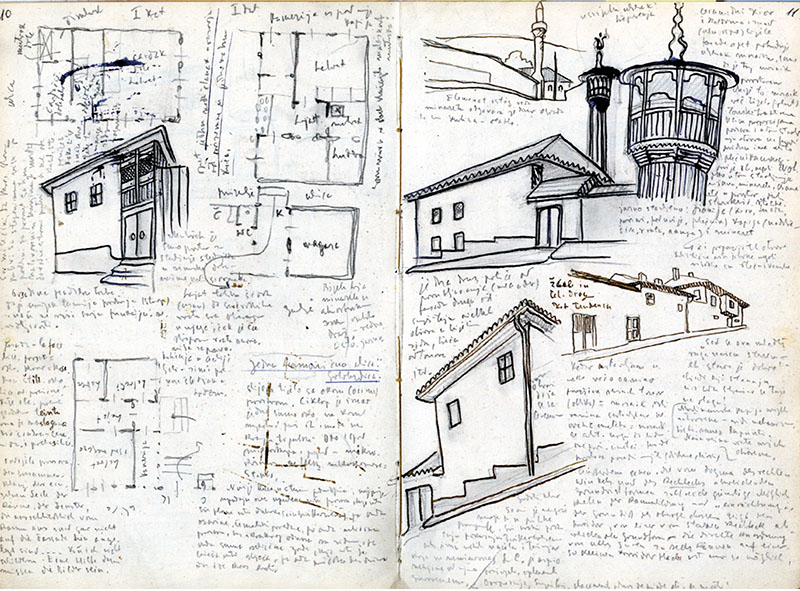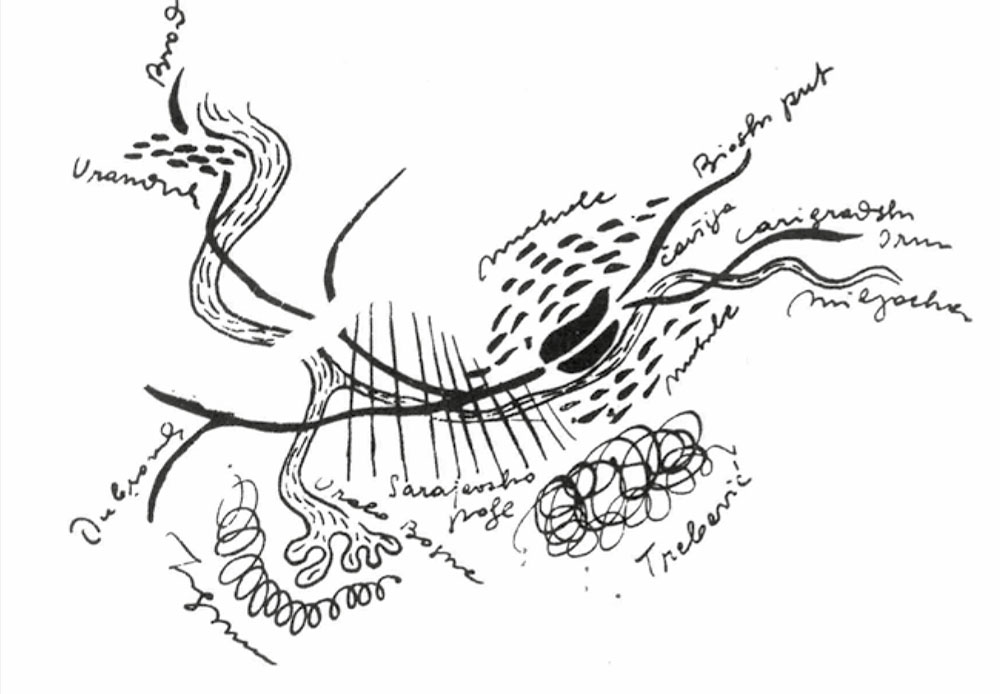
This issue of Docomomo Journal on the architects Dušan Grabrijan (1899-1952) and Juraj Neidhardt (1901-1979) keeps with the tradition of collaboration and discourse. The authors investigate, describe, and interpret the friendship, exchange, and works of both architects and their role in the modernization of Yugoslav architecture since the 1920s based on their international experience. Grabjian, the first graduate of Jože Plečnik at the University of Ljubljana, went to study in Paris in 1925-26, and Neidhardt worked in the studio of Le Corbusier in Paris from 1933-35.
Both Grabrijan and Neidhardt played crucial roles in articulating a Yugoslavian architectural identity that straddled modernism and regionalism. Their work in Bosnia and Herzegovina was groundbreaking in its insistence that modern architecture could not simply be imported from the West; it had to be adapted to the local climate, materials, and ways of life. They both remain influential in the study of how architecture can reconcile the tension between modern abstraction and regional specificity, and their work continues to be studied as a model for integrating global and local architectural practices.
Editorial
-
It is a long-standing and well-appreciated tradition of Docomomo International to emphasize its diversity expressed in buildings, sites, and neighborhoods due to different geography, language, education, and personalities. The term multiple modernisms has been coined to express regional, stylistic, and constructive differences in the formal and philosophical expression of Modern Movement across the globe, within the continents, and even within countries. Docomomo conferences and Docomomo Journals have used and interpreted the term over the last 30 years to express and acknowledge the...
Introduction
-
The richness and multiplicity of themes addressed in the different contributions made it very difficult to create the optimal order for this issue: every grouping of contributions would undervalue at least one of the aspects of the individual papers. Finally this Journal is structured in three main blocks where the first focusses on the joint origins and joint works of Dušan Grabrjan and Juraj Neidhardt. It includes contributions by Bogo Zupančič, Lejla Džumhur with Aida Idrizbegović-Zgonić and Dijana Alić. The second block of papers has the main focus on Plečnik and Dušan Grabrjan’s...
Essays
-
The article presents the archive of architect Dušan Grabrijan at the Museum of Architecture and Design (MAO) in Ljubljana. It describes one of the key moments in the modernization of Slovenian (and Yugoslavian) architecture and society in the 1930s, namely the “invasion” of Le Corbusier’s studio at 35 Rue de Sèvres in Paris by Jože Plečnik’s students. The article primarily focuses on Grabrijan’s correspondence with architects Juraj Neidhardt and Milan Sever, who wrote to Grabrijan in Sarajevo from Paris. Four letters sent to Grabrijan from Paris are just a fraction of the extremely...
-
One of the most striking elements of Dušan Grabrijan’s and Juraj Neidhardt’s oeuvre is the extent and freedom of associations with the contested Ottoman legacy in the first decades of the socialist era in Bosnia and Herzegovina, as seen in their book Architecture of Bosnia and the Way towards Modernity. Such freedom primarily resulted from the increasingly favorable political environment that permitted and encouraged decentralization from the predominantly negative portrayal of the Ottoman past.
This paper seeks to unravel the structure and sources of the main... -
In 1942, Grabrijan and Neidhardt guest-edited an issue of the Croatian architectural journal Technical Gazette (Tehnički Vjesnik). Titled Sarajevo and Its Satellites (Sarajevo i njegovi trabanti), the publication contributed to architectural and urban debates and to the development of the regulatory urban plan of the city of Sarajevo. It allowed the authors to present their design work and writings–both individually and collaboratively–framed by their shared vision of a new master plan for the city.
This paper argues that despite the authors’ interest in and fascination with the... -
The first part of this research is based on the analysis of several articles published by Dušan Grabrijan in the late 1940s and early 1950s, his book Plečnik in njegova šola (Plečnik and His School), and the analysis of Grabrijan’s teaching method rooted in Auguste Choisy’s book Histoire de l’architecture (Choisy, 1899), published as a study script. The book Plečnik in njegova šola (Grabrijan, 1968) is based on Grabrijan’s published and unpublished texts, some of which were originally written during his WWII imprisonment. It attempts to critically contextualize, evaluate, and present...
-
The thesis of this article is two-fold. Firstly, Plečnik’s wartime and post-war projects deserve more research attention than they have received to date. A certain level of under-appreciation of Plečnik’s late work is probably a result of a lower number of realizations and perhaps also of insufficient research of this period compared to Plečnik’s career before that.1 Secondly, the article attempts to prove that in the last fifteen years of Plečnik’s life, the urbanistic character of his work was significantly upgraded. The focus lies on the changed urbanistic character of his wartime and...
-
Grabrijan sought to explain and affirm a coexistence of the modern and the traditional in architecture, especially in his seminal studies of Bosnian architecture and the Macedonian house. Co-authored with Neidhardt, his publication about Bosnian architecture is well-known and studied. Grabrijan’s posthumous publication, The Macedonian House, based on the data collected during his fieldwork in regional towns in Macedonia (1946, 1947, 1949), serves to punctuate the progressive modernizing forces and their focus on reconstruction, urbanization, and speedy industrialization of major centers...
-
This paper seeks to uncover terms of comparability between Bogdan Bogdanović’s and Dušan Grabrijan’s texts, building on a thorough translation and interpretation of the written work published by Bogdanović in Mali Urbanizam and by Grabrijan on Sarajevo between 1936 and 1942. From 1956 to 1958, at the beginning of a successful career as an architect of memorials and monuments, Bogdan Bogdanović produced a monthly column called ‘Mali Urbanizam’ (Small-scale urbanism) in Borba, the Yugoslav publication that bestowed the coveted yearly prize for architecture. This...
-
The article covers the early work of Juraj Neidhardt (Zagreb, 1901-Sarajevo, 1979) and the architectural themes he introduced. Aside from the large-scale urban projects Neidhardt worked on at the time, the Archiepiscopal Boys´ Seminary–integrated into its landscape and determined by its ambience–remains his only built design in the interwar period. And that was before his departure for Europe to work in the studios of Peter Behrens in Berlin and Le Corbusier in Paris.
In 1925, the Construction Committee defined a detailed program for the metropolitan seminary; Neidhardt made... -
The international competition for the new regulation plan of Novi Sad was held in 1937, in which Juraj Neidhardt’s design was awarded compensation instead of a prize. However, upon further consideration, the city administration decided to adopt a new version of Neidhardt’s plan in the following years. In addition to this plan, he won the administration’s trust to design a series of lower-level plans for the city in 1938-1941. Therefore, Neidhardt became the most prominent figure in the urban planning process triggered by the 1937 competition. However, his final regulation plan for the...
-
The concepts of residential space and housing, created by Yugoslav modernist Juraj Neidhardt through the collaboration with architect Dušan Grabrijan, have yet to be investigated systematically, especially from the urban design point of view. As rooted in joint ethnographic research of local Bosnian dwelling culture and vernacular architecture, Neidhardt developed a specific approach to modern neighborhood design compared to the prevalent scientific-planning approach in post-war modernism. From the perspective of urban design, Neidhardt examined the possibilities of conceptualizing more...
-
Some of Juraj Neidhardt’s most emblematic projects are situated in pristine, non-urban settings. From the Ski House in the pine forests of the Bosnian hills to the Hotel Agava immersed in the Mediterranean shrubbery of the Adriatic Coast, his designs in the landscape were key for him to define his architecture as seeking proximity to and harmony with nature. The design strategy that Neidhardt utilized to realize this ambition was, however, far from constant. While in the 1950s, he relied solely on the “unwritten laws” of the vernacular models to define techniques of new design...
Book Reviews
Heritage in danger
-
Almost the entirety of Juraj Neidhardt’s built work was created in the decades of his late career. Although several emblematic projects—notably the ‘Sextuplet’ collective workers’ housing type—were designed before World War II, Neidhardt’s work as modernist heritage is historically firmly situated in the socialist Yugoslav era. The proper evaluation, listing, and conservation of modern architectural heritage is a relatively new subfield of heritage conservation in many countries around the world. In the majority of ex-Yugoslav states, the institutionalization of these endeavors has been...



















